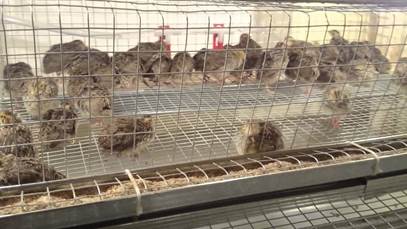Poultry Advisory Services (PAS) Advisory Services
Quail Farming
The most popular quail among different breeds is Japanese quail. In Pakistan Japanese quail has been raised in captivity for many years. The quail has many advantages in comparison to any other small animal for home food production. A Japanese quail reaches sexual maturity at about 6 weeks of age. At this age body weights range from roughly 100 to 150 grams. Females are slightly heavier than males.

EGG PRODUCTION:
The females begin to lay eggs at average of six weeks of age, and continue to produce eggs economically for at least a year. The males can be slaughtered for meat at the age of 6 weeks. Even older animals are easy to butcher and can be prepared for food in a variety of ways.
HOUSING:
These birds need only a small amount of space. The building should be rodent-proof, specially with the floor and lower 3 feet of the walls having no cracks or holes. A cage permitting each bird 225 cm2 of floor space (44 birds per square meter) is the minimum requirement. The cage need not be more than 15 cm in height.
Breeders are typically housed in one of three ways: in large community floor pens, in smaller communal cages designed for 10 to 20 birds each, or caged as pairs or trios. Each of these housing types has advantages and drawbacks.
1. FLOOR PENS
Housing birds in large pens on slatted floors similar to the traditional floor pen setup is successful. There is an added expense to cover the majority of the floor with a removable slatted or wire-type floor, but both bird’s health and eggshell quality often improve.Suggested Minimum Space Requirements for floor pens*
| ----- | 1-10 days |
11 days-6 weeks |
6-14 weeks |
FLOOR SPACE |
4 birds/sq ft |
3 birds/sq ft |
2 birds/sq ft |
FEEDER SPACE |
0.6 inch/bird |
0.6 inch/bird |
1.0 inch/bird |
WATERER SPACE |
0.15 inch/bird |
0.25 inch/bird |
0.3 inch/bird |
*Facilities, equipment, and management will affect space requirements. |
|||
2. WIRE CAGES:
There are several advantages of placing birds in wire cages over the traditional floor pen design. The quality of the eggshell improves and the eggs are much cleaner because they don’t come in direct contact with fecal material as they roll away from the bird shortly after they are laid.

3. COLONY CAGES

A colony cage is the most practical system to house breeders.
LIGHTING
Japanese quail require 16 hours of light per day to maintain maximum egg production and fertility. This means that supplementary lighting must be provided in the autumn, winter and spring months to maintain production.

WATER
Chicks have sufficient material in their yolk sac to survive the first two to three days without feed (assuming the temperature is correct), but they do need water. It is important that the chicks find the water source shortly after arrival to prevent dehydration and death.
FEEDING AND NUTRITION
Quails eat crumbles or mash. The birds consume 0.59 to 0.68 kg per bird of feed during the first 8 weeks. Between 8 and 16 weeks, they consume 0.91 to 1.36 kg per bird. During the hot summer months, feed should not be stored for more than 2 or 3 weeks nor allowed to become damp. During the cooler months, feed may be stored up to 4-6 weeks with a minimum loss of nutrients. Feed consumption varies from farm to farm, season to season and formulation to formulation.
Recommended total protein levels (% age) for Quail
| Species | Starting |
Grower 1 |
Grower 2 |
Holding |
Breeding1 |
Bob White Quail |
26 |
20 |
15 |
14 |
24 |
Japanese Quail |
24 |
Mature at 6 weeks |
Mature at 6 weeks |
14 2 |
20 |
1. Start feeding the breeder diet three weeks before first egg is anticipated.
2. Japanese quail usually are not put on holding ration; a holding diet is sometimes used if they are held on short days to delay production.
EGGS
The average egg from mature female weighs about 10 gram. Japanese quail are prolific layers. The average egg weight is about 10 percent of the hen’s body weight. The young breeders may begin to lay a few eggs as early as 18 weeks of age, do not expect consistent egg production until about 22 weeks of age.
BROODING
The brooding period is the first six weeks of the chick’s life. This critical period is important for getting the chick off to a good start. Regardless of the season, the brooders should run for at least 24 hours before chick arrival, and the litter temperature should be approximately 95oF. Brooding is generally accomplished in circular units about 7 to 8 feet in diameter and 18-inch-high called “brooder rings” they are commonly made of cardboard or inexpensive sheet metal. The brooder ring keeps the chicks in the vicinity of the heat, water and feed. Remove the ring at about eight days of age. Stocking density can be as high as 10 birds per square foot during brooding.
GROWTH
At six weeks of age, chicks are typically moved from the brooding facility to pens/ barns until 17 weeks of age. Advantages of quail barns include a lower incidence of cannibalism and reduced feed cost. From five to 14 weeks of age, birds are grown in the dark to prevent cannibalism. Light stimulates bird activity; thus, less cannibalism occurs with birds grown in dark-out housing.


